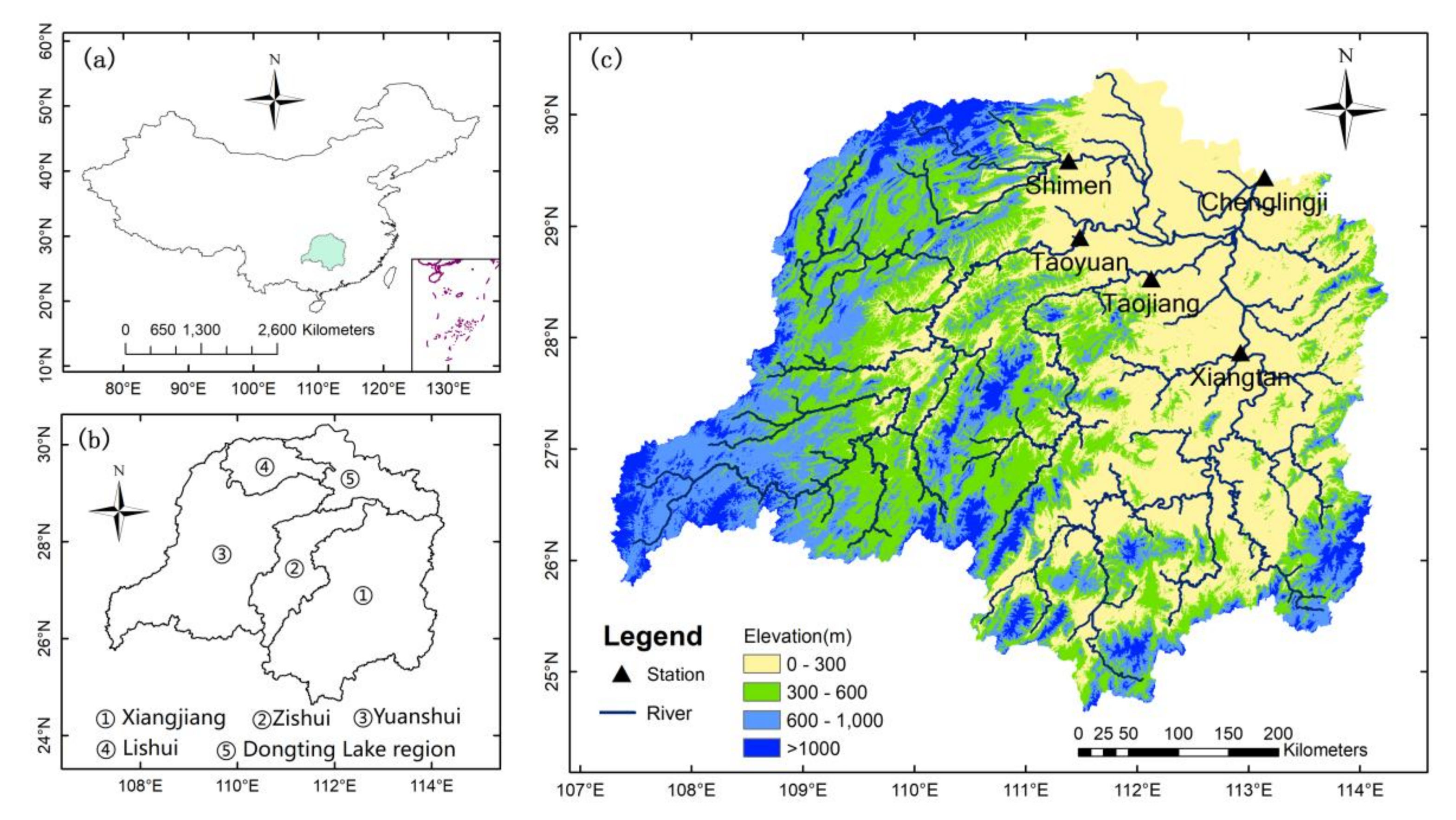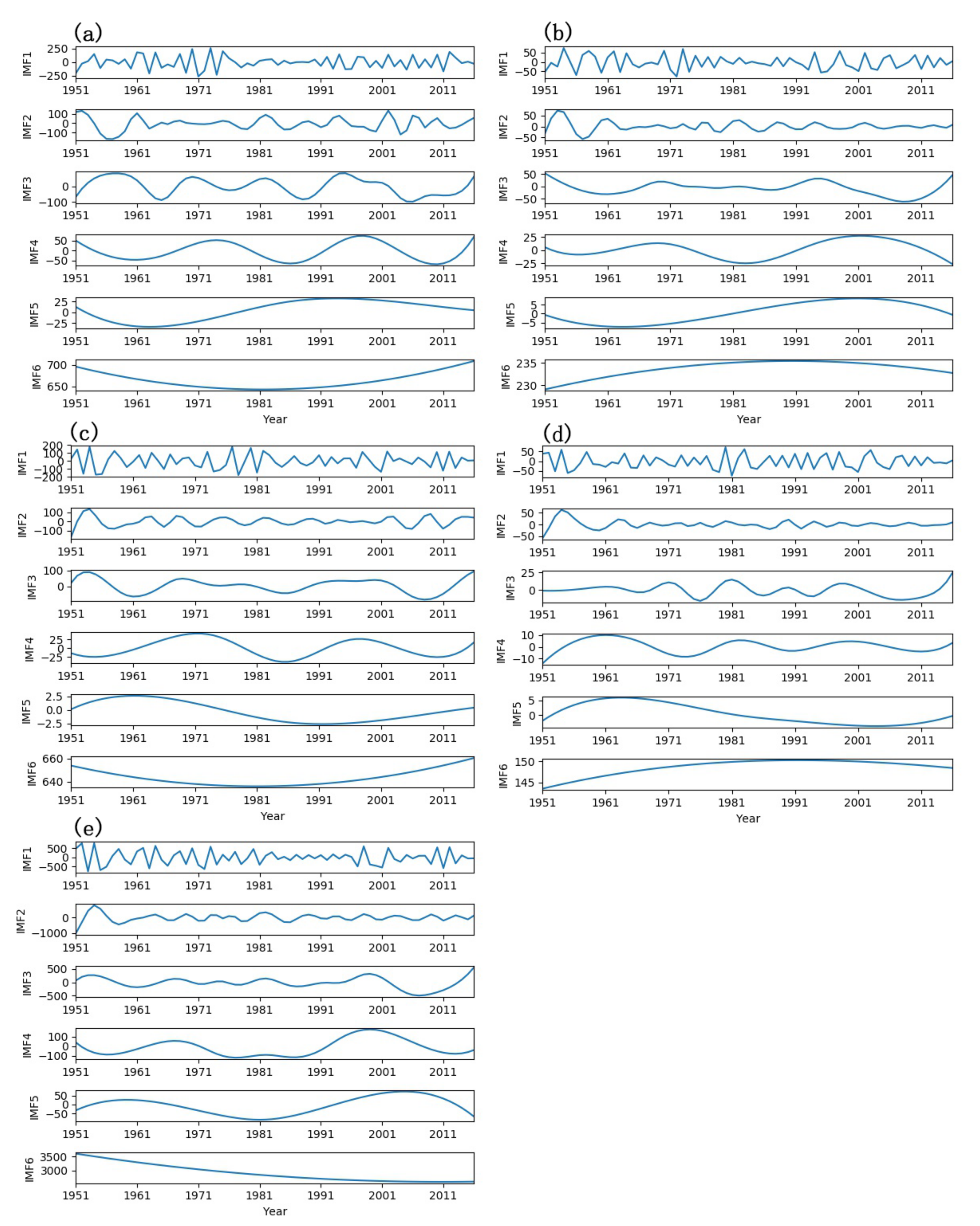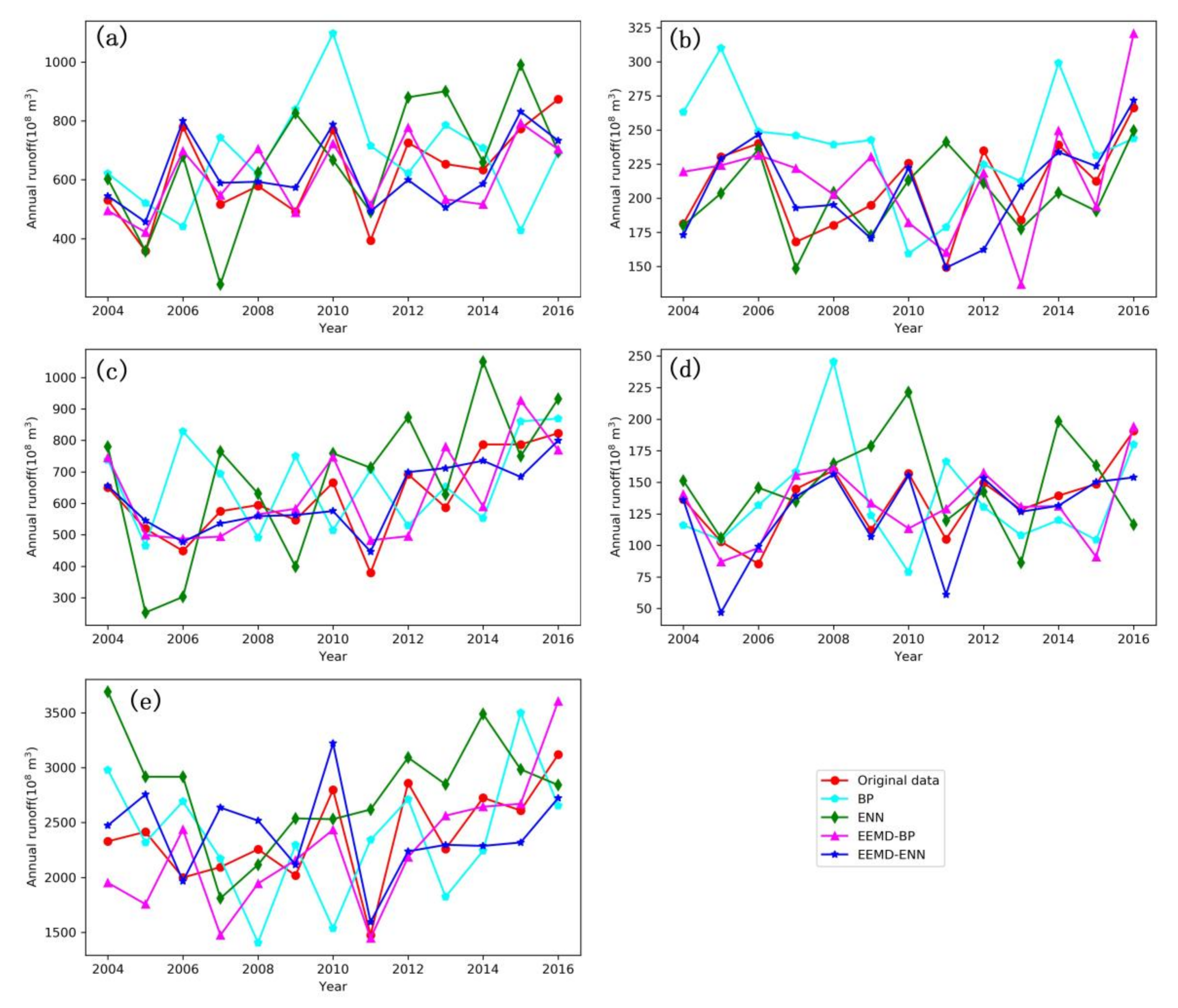A Hybrid Model for Annual Runoff Time Series Forecasting Using Elman Neural Network with Ensemble Empirical Mode Decomposition
Abstract
:1. Introduction
2. Methodology Description of the Proposed Model
2.1. Empirical Mode Decomposition (EMD)
- In the whole data series, the number of extrema must be equal to the number of zero crossing or differ by 1 at most;
- At any point, the mean value of the envelope defined by the local maxima and the minima must be zero.
- Step 1:
- Identify all the local maxima and minima of the original time series ;
- Step 2:
- Using the three-spline interpolation function to create the upper envelopes and the lower envelopes of the time series;
- Step 3:
- Calculate mean value of the upper and lower envelopes ([]/2);
- Step 4:
- Calculate the difference value between time series and mean value ();
- Step 5:
- Check the difference value : (a) if satisfies the two IMF conditions, then is defined as the th IMF, the residue replace the . The th IMF is denoted as ; (b) if is not an IMF, then replace the ;
- Step 6:
- Repeat step (1)–(5) until the residue item becomes a monotone function or the number of extrema is less than or equal to 1, so that the IMF component cannot be decomposed again.
2.2. Ensemble EMD (EEMD)
- Step 1:
- Add white noise to the original time series . The new time series can be defined as:
- Step 2:
- Decompose the new time series into IMFs using EMD method;
- Step 3:
- Repeat steps (1) and (2) with different white noises series each time;
- Step 4:
- Obtain the mean of the ensemble corresponding IMFs of the decompositions as the final result.
2.3. Elman Neural Network (ENN)
2.4. The Proposed Hybrid EEMD-ENN Model
- First step: Nonstationary testing. To reveal, analyze and further study the nonstationary and nonlinear characteristics of annual runoff time series, the Augmented Dickey-Fuller (ADF) test is employed to analyze the stationary of annual runoff time series.
- Second step: Annual time series decomposing. The annual runoff time series are decomposed into several IMFs by using EEMD method.
- Third step: IMFs forecasting. One-step-ahead predicting is conducted for each IMF by using ENN. Several predicted IMFs results are achieved.
- Fourth step: Final predicted IMFs reconstructing. All the predicted results for every IMF are aggregated as the final predicted results for the annual runoff time series.
3. Case Study
3.1. Study Area
3.2. Data Collection
3.3. Evaluation Indexes for Forecasting Performance
3.4. Annual Runoff Time Series Decomposition by EEMD
3.5. Forecasting Each Intrinsic Mode Functions (IMF) Component and Reconstruction
3.6. Analysis and Performance Comparison
4. Conclusions
Acknowledgments
Author Contributions
Conflicts of Interest
References
- Zhang, Q.; Wang, B.-D.; He, B.; Peng, Y.; Ren, M.-L. Singular spectrum analysis and arima hybrid model for annual runoff forecasting. Water Resour. Manag. 2011, 25, 2683–2703. [Google Scholar] [CrossRef]
- Zhao, X.; Chen, X.; Xu, Y.; Xi, D.; Zhang, Y.; Zheng, X. An emd-based chaotic least squares support vector machine hybrid model for annual runoff forecasting. Water 2017, 9, 153. [Google Scholar] [CrossRef]
- Ning, L.; Xia, J.; Zhan, C.; Zhang, Y. Runoff of arid and semi-arid regions simulated and projected by CLM-DTVGM and its multi-scale fluctuations as revealed by EEMD analysis. J. Arid Land 2016, 8, 506–520. [Google Scholar] [CrossRef]
- Bao, A.-M.; Liu, H.-L.; Chen, X.; Pan, X.-L. The effect of estimating areal rainfall using self-similarity topography method on the simulation accuracy of runoff prediction. Hydrol. Process. 2011, 25, 3506–3512. [Google Scholar] [CrossRef]
- Bryant, A.C.; Painter, T.H.; Deems, J.S.; Bender, S.M. Impact of dust radiative forcing in snow on accuracy of operational runoff prediction in the upper Colorado river basin. Geophys. Res. Lett. 2013, 40, 3945–3949. [Google Scholar] [CrossRef]
- Erdal, H.I.; Karakurt, O. Advancing monthly streamflow prediction accuracy of cart models using ensemble learning paradigms. J. Hydrol. 2013, 477, 119–128. [Google Scholar] [CrossRef]
- Wang, W.-C.; Chau, K.-W.; Xu, D.-M.; Chen, X.-Y. Improving forecasting accuracy of annual runoff time series using ARIMA based on EEMD decomposition. Water Resour. Manag. 2015, 29, 2655–2675. [Google Scholar] [CrossRef]
- Wang, W.C.; Chau, K.W.; Qiu, L.; Chen, Y.B. Improving forecasting accuracy of medium and long-term runoff using artificial neural network based on EEMD decomposition. Environ. Res. 2015, 139, 46–54. [Google Scholar] [CrossRef] [PubMed]
- Chen, P.-C.; Wang, Y.-H.; You, G.J.-Y.; Wei, C.-C. Comparison of methods for non-stationary hydrologic frequency analysis: Case study using annual maximum daily precipitation in Taiwan. J. Hydrol. 2017, 545, 197–211. [Google Scholar] [CrossRef]
- Nijssen, B.; Lettenmaier, D.P.; Liang, X.; Wetzel, S.W.; Wood, E.F. Streamflow simulation for continental-scale river basins. Water Resour. Res. 1997, 33, 711–724. [Google Scholar] [CrossRef]
- Zhou, S.; Liang, X.; Chen, J.; Gong, P. An assessment of the VIC-3L hydrological model for the Yangtze River basin based on remote sensing: A case study of the Baohe river basin. Can. J. Remote Sens. 2014, 30, 840–853. [Google Scholar] [CrossRef]
- Srinivasan, R.; Ramanarayanan, T.S.; Arnold, J.G.; Bednarz, S.T. Large area hydrologic modeling and assessment part II: Model application. J. Am. Water Resour. Assoc. 1998, 34, 91–101. [Google Scholar] [CrossRef]
- Arnold, J.G.; Moriasi, D.N.; Gassman, P.W.; Abbaspour, K.C.; White, M.J.; Srinivasan, R.; Santhi, C.; Harmel, R.D.; Griensven, A.v.; Liew, M.W.V.; et al. SWAT: Model use, calibration and validation. Trans. ASABE 2012, 55, 1491–1508. [Google Scholar] [CrossRef]
- Liew, M.W.; Garbrecht, J. Hydrologic simulation of the little Washita river experimental watershed using swat. J. Am. Water Resour. Assoc. 2003, 39, 413–426. [Google Scholar] [CrossRef]
- Lin, K.; Zhang, Q.; Chen, X. An evaluation of impacts of DEM resolution and parameter correlation on TOPMODEL modeling uncertainty. J. Hydrol. 2010, 394, 370–383. [Google Scholar] [CrossRef]
- Devia, G.K.; Ganasri, B.P.; Dwarakish, G.S. A review on hydrological models. Aquat. Procedia 2015, 4, 1001–1007. [Google Scholar] [CrossRef]
- Zhao, X.-H.; Chen, X. Auto regressive and ensemble empirical mode decomposition hybrid model for annual runoff forecasting. Water Resour. Manag. 2015, 29, 2913–2926. [Google Scholar] [CrossRef]
- Wu, C.L.; Chau, K.W.; Li, Y.S. Methods to improve neural network performance in daily flows prediction. J. Hydrol. 2009, 372, 80–93. [Google Scholar] [CrossRef]
- Wu, C.L.; Chau, K.W.; Fan, C. Prediction of rainfall time series using modular artificial neural networks coupled with data-preprocessing techniques. J. Hydrol. 2010, 389, 146–167. [Google Scholar] [CrossRef]
- Taormina, R.; Chau, K.-W. Data-driven input variable selection for rainfall–runoff modeling using binary-coded particle swarm optimization and extreme learning machines. J. Hydrol. 2015, 529, 1617–1632. [Google Scholar] [CrossRef]
- Chau, K.W.; Wu, C.L. A hybrid model coupled with singular spectrum analysis for daily rainfall prediction. J. Hydroinform. 2010, 12, 458–473. [Google Scholar] [CrossRef]
- Humphrey, G.B.; Gibbs, M.S.; Dandy, G.C.; Maier, H.R. A hybrid approach to monthly streamflow forecasting: Integrating hydrological model outputs into a bayesian artificial neural network. J. Hydrol. 2016, 540, 623–640. [Google Scholar] [CrossRef]
- Wei, S.; Yang, H.; Song, J.; Abbaspour, K.; Xu, Z. A wavelet-neural network hybrid modelling approach for estimating and predicting river monthly flows. Hydrol. Sci. J. 2013, 58, 374–389. [Google Scholar] [CrossRef]
- Niu, W.-J.; Feng, Z.-K.; Cheng, C.-T.; Zhou, J.-Z. Forecasting daily runoff by extreme learning machine based on quantum-behaved particle swarm optimization. J. Hydrol. Eng. 2018, 23, 04018002. [Google Scholar] [CrossRef]
- Asadi, S.; Shahrabi, J.; Abbaszadeh, P.; Tabanmehr, S. A new hybrid artificial neural networks for rainfall–runoff process modeling. Neurocomputing 2013, 121, 470–480. [Google Scholar] [CrossRef]
- Wu, Z.; Huang, N.E. Ensemble empirical mode decomposition: A noise-assisted data analysis method. Adv. Adapt. Data Anal. 2009, 1, 1–41. [Google Scholar] [CrossRef]
- Huang, N.E.; Shen, Z.; Long, S.R.; Wu, M.C.; Shih, H.H.; Zheng, Q.; Yen, N.C.; Tung, C.C.; Liu, H.H. The empirical mode decomposition and the hilbert spectrum for nonlinear and non-stationary time series analysis. Proc. R. Soc. A Math. Phys. Eng. Sci. 1998, 454, 903–995. [Google Scholar] [CrossRef]
- Kang, A.; Tan, Q.; Yuan, X.; Lei, X.; Yuan, Y. Short-term wind speed prediction using EEMD-LSSVM model. Adv. Meteorol. 2017, 2017, 1–22. [Google Scholar] [CrossRef]
- Wang, C.; Zhang, H.L.; Fan, W.H.; Ma, P. A new chaotic time series hybrid prediction method of wind power based on EEMD-SE and full-parameters continued fraction. Energy 2017, 138, 977–990. [Google Scholar] [CrossRef]
- Niu, M.; Gan, K.; Sun, S.; Li, F. Application of decomposition-ensemble learning paradigm with phase space reconstruction for day-ahead PM2.5 concentration forecasting. J. Environ. Manag. 2017, 196, 110–118. [Google Scholar] [CrossRef] [PubMed]
- Zhang, N.; Lin, A.; Shang, P. Multidimensionalk-nearest neighbor model based on EEMD for financial time series forecasting. Phys. A Stat. Mech. Appl. 2017, 477, 161–173. [Google Scholar] [CrossRef]
- Lan, H.; Yin, H.; Hong, Y.-Y.; Wen, S.; Yu, D.C.; Cheng, P. Day-ahead spatio-temporal forecasting of solar irradiation along a navigation route. Appl. Energy 2018, 211, 15–27. [Google Scholar] [CrossRef]
- Ouyang, Q.; Lu, W.; Xin, X.; Zhang, Y.; Cheng, W.; Yu, T. Monthly rainfall forecasting using EEMD-SVR based on phase-space reconstruction. Water Resour. Manag. 2016, 30, 2311–2325. [Google Scholar] [CrossRef]
- Wang, W.-C.; Xu, D.-M.; Chau, K.-W.; Chen, S. Improved annual rainfall-runoff forecasting using PSO–SVM model based on EEMD. J. Hydroinform. 2013, 15, 1377–1390. [Google Scholar] [CrossRef]
- Barge, J.; Sharif, H. An ensemble empirical mode decomposition, self-organizing map and linear genetic programming approach for forecasting river streamflow. Water 2016, 8, 247. [Google Scholar] [CrossRef]
- Huang, N.E.; Shen, Z.; Long, S.R. A new view of nonlinear water waves: The hilbert spectrum. Annu. Rev. Fluid Mech. 1999, 31, 417–457. [Google Scholar] [CrossRef]
- Elman, J. Finding structure in time. Cognit. Sci. 1990, 14, 179–211. [Google Scholar] [CrossRef]
- Pan, Y.; Li, Y.; Ma, P.; Liang, D. New approach of friction model and identification for hydraulic system based on MAPSO-NMDS optimization Elman neural network. Adv. Mech. Eng. 2017, 9. [Google Scholar] [CrossRef]
- Ardalani-Farsa, M.; Zolfaghari, S. Chaotic time series prediction with residual analysis method using hybrid Elman–NARX neural networks. Neurocomputing 2010, 73, 2540–2553. [Google Scholar] [CrossRef]
- Kolanowski, K.; Świetlicka, A.; Kapela, R.; Pochmara, J.; Rybarczyk, A. Multisensor data fusion using Elman neural networks. Appl. Math. Comput. 2018, 319, 236–244. [Google Scholar] [CrossRef]
- Hayashi, S.; Murakami, S.; Xu, K.-Q.; Watanabe, M. Effect of the three gorges dam project on flood control in the Dongting Lake area, China, in a 1998-type flood. J. Hydro-Environ. Res. 2008, 2, 148–163. [Google Scholar] [CrossRef]
- Nash, J.E.; Sutcliffe, J.V. River flow forecasting through conceptual models part I—A discussion of principles. J. Hydrol. 1970, 10, 282–290. [Google Scholar] [CrossRef]
- Xu, J.; Chen, Y.; Bai, L.; Xu, Y. A hybrid model to simulate the annual runoff of the Kaidu River in northwest China. Hydrol. Earth Syst. Sci. 2016, 20, 1447–1457. [Google Scholar] [CrossRef]




| Station | Period | Min. (108 m3) | Max. (108 m3) | Mean (108 m3) | Variance | Standard Deviation | Skewness | Kurtosis |
|---|---|---|---|---|---|---|---|---|
| Xiangtan | 1951–2016 (Original dataset) | 280.6 | 1031.9 | 654.5 | 27,120.48 | 164.68 | 0.24 | 2.45 |
| 1951–2003 (Training) | 280.6 | 1031.9 | 662.62 | 27,719.49 | 166.49 | 0.30 | 2.45 | |
| 2004–2016 (Testing) | 358.2 | 873.1 | 621.44 | 25,309.80 | 159.09 | −0.14 | 1.93 | |
| Taojiang | 1951–2016 (Original dataset) | 103.1 | 372.3 | 226.97 | 2545.16 | 50.45 | 0.51 | 3.72 |
| 1951–2003 (Training) | 103.1 | 372.3 | 231.59 | 2797.73 | 52.89 | 0.41 | 3.51 | |
| 2004–2016 (Testing) | 149.2 | 266.3 | 208.16 | 1185.30 | 34.43 | −0.07 | 1.95 | |
| Taoyuan | 1951–2016 (Original dataset) | 379.4 | 1030 | 643.51 | 15,285.81 | 123.64 | 0.42 | 3.1 |
| 1951–2003 (Training) | 454 | 1030 | 649.35 | 14,860.84 | 121.91 | 0.59 | 3.22 | |
| 2004–2016 (Testing) | 379.4 | 822.7 | 619.73 | 17,638.21 | 132.81 | −0.08 | 2.21 | |
| Shimen | 1951–2016 (Original dataset) | 82.98 | 264 | 146.54 | 1533.31 | 39.16 | 0.76 | 3.35 |
| 1951–2003 (Training) | 82.98 | 264 | 149.29 | 1691.78 | 41.13 | 0.71 | 3.05 | |
| 2004–2016 (Testing) | 85.35 | 190.7 | 135.33 | 804.74 | 28.37 | 0.001 | 2.58 | |
| Chenglingji | 1951–2016 (Original dataset) | 1475 | 5268 | 2846.04 | 379,561.32 | 616.09 | 1.00 | 5.45 |
| 1951–2003 (Training) | 1990 | 5268 | 2960.01 | 362,336.39 | 601.95 | 1.19 | 5.59 | |
| 2004–2016 (Testing) | 1475 | 3119 | 2381.38 | 194,570.92 | 441.10 | −0.24 | 2.66 |
| Station | h | p-Value | t-Value | Critical Value |
|---|---|---|---|---|
| Xiangtan | 0 | 0.1952 | −1.2402 | −1.9454 |
| Taojiang | 0 | 0.2679 | −1.0391 | −1.9454 |
| Taoyuan | 0 | 0.3553 | −0.8001 | −1.9454 |
| Shimen | 0 | 0.1332 | −1.4624 | −1.9454 |
| Chenglingji | 0 | 0.2825 | −0.9993 | −1.9454 |
| Station | Mode | MAE (108 m3) | MAPE (%) | RMSE (108 m3) | R | NSCE |
|---|---|---|---|---|---|---|
| Xiangtan | BP | 206.79 | 62,027.17 | 235.17 | 0.002 | −1.36 |
| ENN | 141.82 | 62,035.71 | 172.40 | 0.59 * | −0.27 | |
| EEMD-BP | 75.91 | 62,043.40 | 90.13 | 0.81 ** | 0.65 | |
| EEMD-ENN | 72.12 | 62,040.99 | 85.65 | 0.83 ** | 0.69 | |
| Taojiang | BP | 45.45 | 20,699.68 | 52.36 | 0.32 | −1.51 |
| ENN | 23.58 | 20,717.12 | 32.09 | 0.47 | 0.06 | |
| EEMD-BP | 28.13 | 20,712.44 | 32.92 | 0.66 * | 0.18 | |
| EEMD-ENN | 15.61 | 20,716.65 | 24.18 | 0.75 ** | 0.47 | |
| Taoyuan | BP | 154.46 | 61,860.46 | 184.77 | 0.09 | −1.10 |
| ENN | 123.34 | 61,872.48 | 145.33 | 0.43 | −0.30 | |
| EEMD-BP | 97.22 | 61,870.23 | 115.70 | 0.64 * | 0.18 | |
| EEMD-ENN | 47.46 | 61,872.61 | 59.99 | 0.89 ** | 0.78 | |
| Shimen | BP | 33.28 | 13,429.19 | 42.44 | 0.29 | −1.43 |
| ENN | 33.48 | 3419.55 | 42.76 | 0.20 | −1.46 | |
| EEMD-BP | 16.48 | 13,433.51 | 23.17 | 0.67 * | 0.28 | |
| EEMD-ENN | 14.00 | 13,441.56 | 22.88 | 0.82 ** | 0.30 | |
| Chenglingji | BP | 553.40 | 23,803.62 | 651.45 | 0.13 | −1.36 |
| ENN | 567.08 | 238,017.94 | 673.54 | 0.33 | −1.53 | |
| EEMD-BP | 349.40 | 23,804.37 | 410.83 | 0.51 * | 0.06 | |
| EEMD-ENN | 288.16 | 238,036.61 | 342.40 | 0.65 ** | 0.35 |
© 2018 by the authors. Licensee MDPI, Basel, Switzerland. This article is an open access article distributed under the terms and conditions of the Creative Commons Attribution (CC BY) license (http://creativecommons.org/licenses/by/4.0/).
Share and Cite
Zhang, X.; Zhang, Q.; Zhang, G.; Nie, Z.; Gui, Z. A Hybrid Model for Annual Runoff Time Series Forecasting Using Elman Neural Network with Ensemble Empirical Mode Decomposition. Water 2018, 10, 416. https://doi.org/10.3390/w10040416
Zhang X, Zhang Q, Zhang G, Nie Z, Gui Z. A Hybrid Model for Annual Runoff Time Series Forecasting Using Elman Neural Network with Ensemble Empirical Mode Decomposition. Water. 2018; 10(4):416. https://doi.org/10.3390/w10040416
Chicago/Turabian StyleZhang, Xike, Qiuwen Zhang, Gui Zhang, Zhiping Nie, and Zifan Gui. 2018. "A Hybrid Model for Annual Runoff Time Series Forecasting Using Elman Neural Network with Ensemble Empirical Mode Decomposition" Water 10, no. 4: 416. https://doi.org/10.3390/w10040416
APA StyleZhang, X., Zhang, Q., Zhang, G., Nie, Z., & Gui, Z. (2018). A Hybrid Model for Annual Runoff Time Series Forecasting Using Elman Neural Network with Ensemble Empirical Mode Decomposition. Water, 10(4), 416. https://doi.org/10.3390/w10040416




